Related Research Articles

Halebidu is a town located in Hassan District, Karnataka, India. Historically known as Dwarasamudra, Halebidu became the regal capital of the Hoysala Empire in the 11th century CE. In the modern era literature it is sometimes referred to as Halebeedu or Halebid as the phonetic equivalent, a local name after it was damaged and deserted after being ransacked and looted twice by the forces of the Turko-Persian Delhi Sultanate in the 14th century.

Shravanabelagola is a town located near Channarayapatna of Hassan district in the Indian state of Karnataka and is 144 km (89 mi) from Bengaluru. The Gommateshwara Bahubali statue at Shravanabelagola is one of the most important tirthas in Jainism, one that reached a peak in architectural and sculptural activity under the patronage of Western Ganga dynasty of Talakad. Chandragupta Maurya is said to have died on the hill of Chandragiri, which is located in Shravanabelagola, in 298 BCE after he became a Jain monk and assumed an ascetic life style.

Belur is a town and taluk in Hassan district in the state of Karnataka, India. The town is renowned for its Chennakeshava Temple dedicated to Vishnu, one of the finest examples of Hoysala architecture and the largest Hindu temple complex that has survived from pre-14th-century Karnata-Dravida tradition. A historic site inspired by the teachings of Ramanujacharya, it has been a Vaishnava Hindu pilgrimage center since at least the 12th century. It was also the first capital of the Hoysala dynasty, before they built Dwarasamudra.
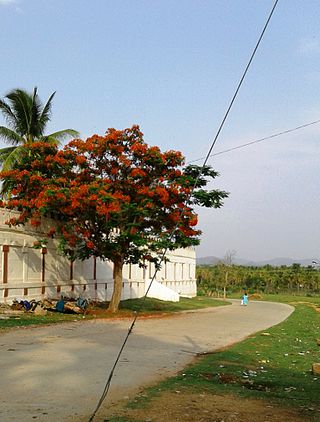
Arsikere is a city and taluka in the Hassan district in the state of Karnataka, India. It is the second largest city in Hassan district, demographically. Arsikere city municipal council consists of 35 wards. This region is known for its coconut production and is also called Kalpataru Nadu. Arsikere Junction is a major railway junction in the South Western Railway which links Mangalore and Mysore to North Karnataka and a central place for tourists who visit nearby places that do not have rail access, such as Belur, Halebidu and Shravanabelagola, Harnahalli, and Kodimata.

Hassan is one of the 31 districts of Karnataka, India. The district headquarter is Hassan. It was part of Manjarabad Faujdari a.k.a Patnada Rayada between 1832-81. In 1882, it was reduced into a sub-division under erstwhile Kadur district. But in 1886, the Hassan district was restored to its current form.

Lakkundi, also referred to as Lokkugundi, was a major city before the 14th century, and is now a village in Gadag District of Karnataka, India. By 10th century, it was already a major economic and commerce center with mint operations for South India, one mentioned in Kannada and Sanskrit inscriptions and texts. By 12th century, many Hindu and Jain temples had been consecrated here, along with public infrastructure such as stepwells and water reservoirs. Among the major temples are the Brahma Jinalaya (oldest), Mallikarjuna, Lakshminarayana, Manikeshwara, Naganatha, Kumbheshvara, Nanneshwara, Someshwara, Narayana, Nilakanteshwara, Kasivisesvara, Virabhadhara, Virupaksha, and others. As its importance and wealth grew, Lakkundi became one of the capitals of the Hoysala Empire.
Kunigal is a town in Tumakuru district in the Indian state of Karnataka. It is the headquarters of Kunigal taluk. As of 2011 census, the town has a population of 34155.
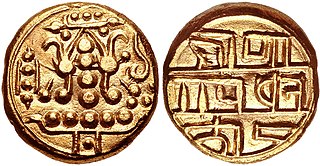
The Alupa dynasty was an ancient ruling dynasty of India. The kingdom they ruled was known as Alvakheda Arusasira and its territory spanned the coastal districts of the modern Indian state known as Karnataka. The Alupas in their prime were an independent dynasty, centuries after reigning due to the dominance of Kadambas from Banavasi, they became feudatory to them. Later they became the vassals of the Chalukyas, Rashtrakutas, Hoysalas with the change in political scenario of Southern India. Their influence over coastal Karnataka lasted for about 1200 years. There is evidence that the Alupas followed the law of matrilineal inheritance (Appekatt/Aliyasantana) since the Alupa king Soyideva was succeeded by his nephew Kulasekhara Bankideva. The legendary king who is credited with introducing matrilineality in South Canara Kheda is named Bhuta Alupa Pandya The descendants of this dynasty still survive to this date and have spread in the karavali region and they are widely referred to as the Bunt. The Bunts follow Matrilineality instead of the common Patrilineality, and are said to be Nagavanshi Kshatriyas by their maternal origin. They can be identified with their surnames such as Shetty, Rai, Hegde, Alva, Chowta etc. Even though most Bunt are Hindus by faith now, The sizeable section of the community still follows Jainism and they are called Jain Bunt The last Alupa king to have ruled is Kulasekharadeva Alupendradeva whose inscription dated 1444 CE have been found in Mudabidri Jain Basadi.
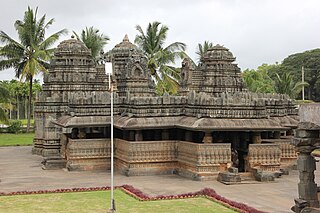
Balligavi a town in Shikaripura taluk Shivamogga district of Karnataka state, India, is today known as Belagami or Balagame. Its ancient names are Baligrama, Dakshina Kedara, Valliggame and Valligrame. Dakshina Kedara means Kedarnath of the South. A place of antiquity, it is known for its ancient monuments. Balligavi is located 72 km from Shivamogga city and 21 km from Shikaripura town and 2.3 km from Shiralakoppa in Shikaripura taluk. Balli in Kannada means creeper or vine.
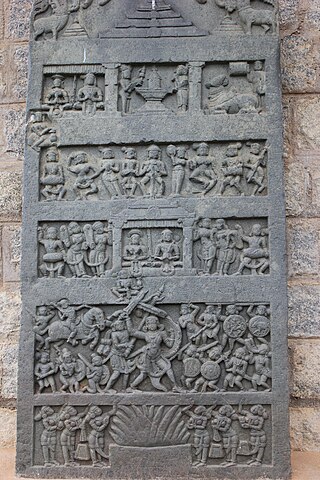
A hero stone is a memorial commemorating the honorable death of a hero in battle. Erected between the second half of the first millennium BCE and the 18th century CE, hero stones are found all over India. They often carry inscriptions and a variety of ornaments, including bas relief panels, frieze, and figures in carved stone. Usually they are in the form of a stone monument and may have an inscription at the bottom with a narrative of the battle. The earliest and oldest of such memorial hero stones is found in the Indian state of Tamil Nadu is more than 2400 years old that is 4th century BCE. According to the historian Upinder Singh, the largest concentration of such memorial stones is found in the Indian state of Karnataka. About two thousand six hundred and fifty hero stones, the earliest in Karnataka is dated to the 5th century CE. The custom of erecting memorial stones dates back to the Iron Age though a vast majority were erected between the 4th century BCE to 13th centuries CE.

The Ishvara temple, also referred to as the Ishwara or Isvara temple, is an early 13th-century Hindu temple in Arsikere, Hassan district, Karnataka India. Dedicated to Shiva, it is one of the most notable early Hoysala architecture examples with a rotating circular plan, a domed mandapa with 16-point star shape, a pancatala vimana, and a galaxy of artwork depicting Shaivism, Vaishnavism, Shaktism and Vedic legends of Hinduism.

Hedathale is a village in the southern state of Karnataka, India. It is located in the Nanjangud taluk of Mysore district in Karnataka. It is a divine and unique Hindu religious centre.

Agrahara Belaguli is a village in Karnataka, India. It is situated about 25 km northeast from Channarayapattana in Hassan district. It was a major town before the 14th-century during the Hoysala times. Early inscriptions here date from the 11th and 12th-century. Kesava Dannayaka – a general of king Vira Ballala, added several Hoysala temples dedicated to Shiva and Vishnu here in early 13th-century. He also constructed a water reservoir called Kesavasamudra. This historic water infrastructure is now to the west of the village. The village became an Agrahara who were believed to be following Shatkarmas in the second half of the 13th-century, renamed as Kesavapura. This town was destroyed after the 13th-century. Belaguli is now a small village, and most of the historic temples ruined. Of these, the Betteshvara temple – Kesavesvara temple in inscriptions survives in the most preserved form. This is a twin-temple, with two equal sanctums, one dedicated to Kesava-Vishnu and other to Isvara-Shiva. It has beautifully carved pillars and partly mutilated remains of Shaivism, Vaishnavism, Shaktism and Vedic deity relief panels.

Bucesvara temple, also referred to as the Buceswara, Bucheshwara or Bhucheshvara temple, is a 12th-century Hindu temples in Koravangala village, Karnataka, India. The most sophisticated historical temple in the village, it is considered to be the flag-bearer of Hoysala architecture and was built by a wealthy patron named Buchi during the reign of king Ballala.
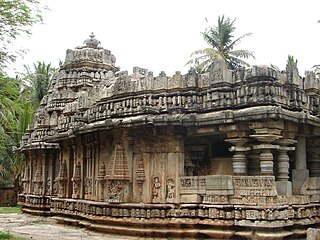
The Brahmeshvara temple, also referred to as the Brahmeshwara or Brahmesvara temple, is a 12th-century Hindu temple with Hoysala architecture in Kikkeri village, Mandya district of Karnataka state, India. Along with two other major historic temples within the village, the Brahmeshvara temple is one of many major ruined temples with notable artwork in Kikkeri area close to the more famous monuments of Shravanabelagola.
Singarasa was a local chieftain holding the title of Maha-Samantha, who had his headquarters at Arasikere, Hassan district, Karnataka, India, in the 12th century CE. He was a popular chieftain of his time, and several places in Karnataka are named after him, for example Singatagere, Singanamane, Singanagadde and Singasandra. Several chieftains with the same or similar names ruled various parts of Karnataka from the 10th century CE onwards.

About 25,000 inscriptions found in Karnataka and nearby states belong to historic Kannada rulers, including the Kadambas, the Western Ganga Dynasty, the Rashtrakuta, the Chalukya, the Hoysala and the Vijayanagara Empire. Many inscriptions related to Jainism have been unearthed. The inscriptions found are generally on stone (Shilashasana) or copper plates (Tamarashasana). These Kannada inscriptions are found on historical hero stones, coins, temple walls, pillars, tablets and rock edicts. They have contributed towards Kannada literature and helped to classify the eras of Proto Kannada, Pre Old Kannada, Old Kannada, Middle Kannada and New Kannada. Inscriptions depict the culture, tradition and prosperity of their era. The literature of Ramayana and Mahabharata are transferred through the generations by these inscriptions. The Hazara Rama Temple and Aranmula Parthasarathy Temple are the best examples of temples associated with Kannada inscriptions.
Aane Kannambadi is a village in Hassan, Karnataka. It is located on the Hassan – Mysore state highway and is about 25 km from Holenarasipura.

Shantinatha Basadi, a Jain temple dedicated to the sixteenth Tirthankar Shantinatha is located in the historically important temple town of Jinanathapura near Shravanabelagola. It is a village in Channarayapatna taluk in the Hassan district of Karnataka state, India.
References
- 1 2 3 4 5 6 7 8 Singh, Upinder (2008). A History of Ancient and Early Medieval India: From the Stone Age to the 12th Century. New Delhi: Pearson Education India. p. 593. ISBN 9788131711200 . Retrieved 21 August 2012.
- 1 2 Ray, Niharranjan; B D, Chattopadhyaya; Chakravarthi, Ranabir; Mani, V R (2000). A Source book of Indian Civilization. Hyderabad: Orient Blackswan. p. 637. ISBN 9788125018711 . Retrieved 8 August 2012.
13°31′N76°19′E / 13.517°N 76.317°E